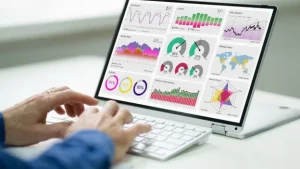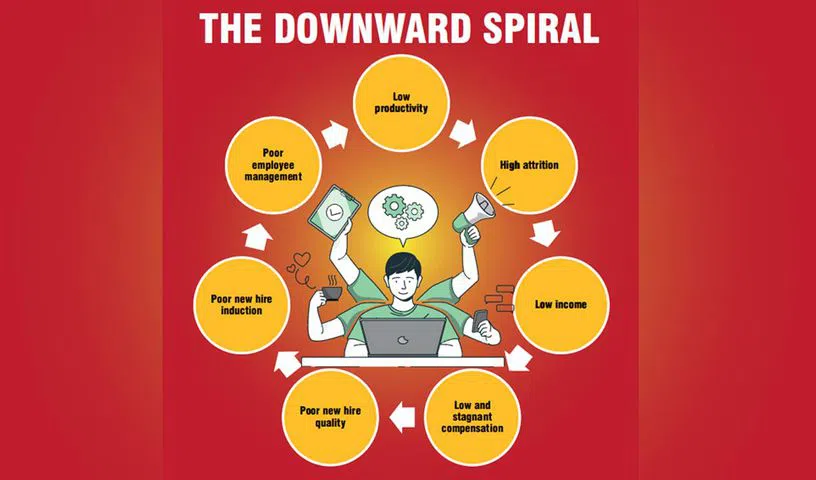The world of AI, ML, big data analytics, and generative AI represent not just individual technological advancements, but a combined force revolutionizing how we work. In this article, let’s explore how this revolution will dramatically reshape the HR function and its evolving role.
HR, by its very nature, revolves around people. However, the landscape of work is undergoing a significant shift. first, the traditional full-time employment models are giving way to a more diverse workforce with part-time roles, contracts, gigs, and outsourced teams. Here’s the crux of the issue –is the current HR function, primarily focused on full-time employees, equipped to handle this evolving workforce? Can they effectively hire, engage, and compensate gig workers, for instance? There’s a chance they might not be fully prepared.
The second trend is about the composition of the workforce – by one estimate the full-time workforce will dramatically drop from 100% today to less than 20%. We at TMI Group are already in this phase with less than 50% of the workforce in full-time engagement. Does the HR team understand how to get work done – without using authority – from the 80% workforce engaged in other forms of employment? Not so sure.
The third big trend is about “where work is done”. The HR function has developed expertise in employees working from offices or factories. Today, “work from anywhere” is the new model – from home, from any remote location. Currently, time spent at the office is a key measure of effort made and hence the attendance system became crucial. But when people work remotely, time cannot be the main measurement. When you work, and how long you work is not relevant. Then how do we measure people? The HR function must move to daily output as a measure – on lead indicators of performance. Does HR know how to move from time to daily output measurement models? Not so sure.
The fourth big trend is the era of automation. This era requires man and machine to work together. Repetitive tasks will be automated. Rule-based work will be automated. This means role descriptions will be rewritten and most importantly the human part of the role will become more specialised. The HR function has to learn to work with a set of specialists who have high egos, zero employer loyalty, zero fear of losing the job, and intolerance for authority. How will we motivate these specialists? A great example of an industry that is already close to the future world of work of specialists is the film industry with actors, directors, camera teams, and production teams. Here the film industry works from project to project and each time with a different set of people. If we ask an HR leader to manage the specialists in the film industry, it will be a nightmare. For example, HR in an R&D centre or a university struggles even today. Does HR know how to learn to extract work from specialists? Not so sure.
The fifth big trend is Gen Z’s attitude towards work, which has no loyalty component. Youth only care about their role and compensation and care far less about employer loyalty. Tenures are shrinking. Frontline and supervisory tenures are falling to less than 12 months. Middle management tenures are less than 2 years. Senior manager tenures are less than 3 years. Does HR today know how to manage and extract outcomes from employees who have short tenures? Not so sure.
In short, the HR function must ask a simple question. How do we stay relevant in the enterprise when the above five trends are happening simultaneously and in ten years will become the norm?
Future of HR
It is time HR moves beyond perfecting the HR processes. HR functions in enterprises have evolved over the last 75 years, from labour management to people management. We have successfully automated many of over 18 HR processes.
The HR function has aligned with business ever since Dave Ulrich’s HR model, published in 1995, helped to organise roles and responsibilities across HR departments, and this is over 30 years old. Today, HR has mastered the art of aligning the processes in talent acquisition, talent development, employee engagement, and compensation management.
Now the stakes have changed. Alignment is not enough. HR must go beyond into outcomes.
Let me give an example. In frontline recruiting teams, we are responsible for ensuring manning at the lowest cost in alignment with business growth. But today HR must go beyond to ensure people stay and perform quickly. Manning metrics are not enough. What percentage of hires, at the end of 12 months, are in the top performance bucket?
But one area that is stuck in the circa 1970s is the performance management system (PMS). HR left performance extraction to line managers. PMS was set up as a process with timelines and rewards, and HR’s role was to ensure compliance, but PMS failed to cope with new work realities and the challenges of performance extraction in the new world of work. The HR role has now changed to architecting people’s performance.
What is the future of HCM?
People performance – full-time or part-time employee, on-roll or outsourced employee, salaried employee or gig worker – is the future of HCM. The HR department must become experts in understanding and architecting performance extraction for every role.
This will impact every HR sub-function. Hiring to fill a vacancy will become hiring for quick performance. Induction for employee engagement will become induction for quick performance. Employee engagement for retention will become engagement for quick performance. Employee data analytics for compliance will become analytics for performance.
Early performance extraction
In this new work world, employee loyalty is falling, employee engagements are declining, attrition is increasing, and employee mercenary behaviour is increasing. The HCM challenge is not just retention. It is early performance extraction.
Role of data analytics in performance extraction
Historically, HR policies were driven by the HR philosophy that enterprises must engage with employees and work on long-term policies that will create the right environment for employees to excel at work. Performance is deemed to be the consequence of these policies.
Also Read: Building a future-ready workforce in the manufacturing sector
In our mind, this will not work when the workforce is now transactional and has short tenures. We need a new HR philosophy for the future which recognises this workforce philosophy.
New HCM philosophy
Every individual comes to work for a reason, and it is primarily self-interest. It may be compensation, work challenges, or work atmosphere. Similarly, organisations engage the workforce with self-interest. Work outcomes commensurate with the employee compensation. This puts people’s performance at the centre of HCM.
What is people’s performance?
People’s performance has three components – outcomes, outputs, and effort or input. Outcomes are what employers want, and these are lag indicators. For example, for salesmen selling home loans, outcomes are the value of home loans disbursed. But these are measured and reported after the month is over. Effort is time spent in the market and in sales activities. But daily output is the output achieved daily on quantity and quality outputs on a few critical tasks in the role.
HR will have to do much more than align HR with business. HR must take co-ownership with the line manager for people’s performance in the new changed world of work. And it must happen now. Are we ready?
Mark your calendar and be part of the future of HR at People Matters TechHR India 2024! Stay tuned with #TechHRIN to follow more conference-related content.


